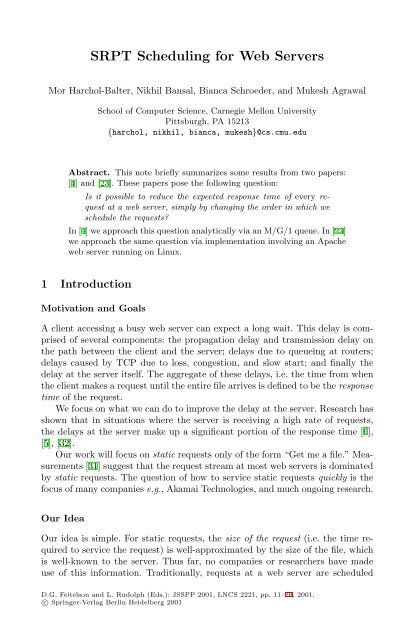LNCS 0558 -Job Scheduling Strategies for Parallel Processing
LNCS 0558 -Job Scheduling Strategies for Parallel Processing
LNCS 0558 -Job Scheduling Strategies for Parallel Processing
Create successful ePaper yourself
Turn your PDF publications into a flip-book with our unique Google optimized e-Paper software.
SRPT <strong>Scheduling</strong> <strong>for</strong> Web Servers<br />
Mor Harchol-Balter, Nikhil Bansal, Bianca Schroeder, and Mukesh Agrawal<br />
School of Computer Science, Carnegie Mellon University<br />
Pittsburgh, PA 15213<br />
{harchol, nikhil, bianca, mukesh}@cs.cmu.edu<br />
Abstract. This note briefly summarizes some results from two papers:<br />
[4] and [23]. These papers pose the following question:<br />
Is it possible to reduce the expected response time of every request<br />
at a web server, simply by changing the order in which we<br />
schedule the requests?<br />
In [4] we approach this question analytically via an M/G/1 queue. In [23]<br />
we approach the same question via implementation involving an Apache<br />
web server running on Linux.<br />
1 Introduction<br />
Motivation and Goals<br />
A client accessing a busy web server can expect a long wait. This delay is comprised<br />
of several components: the propagation delay and transmission delay on<br />
the path between the client and the server; delays due to queueing at routers;<br />
delays caused by TCP due to loss, congestion, and slow start; and finally the<br />
delay at the server itself. The aggregate of these delays, i.e. the time from when<br />
the client makes a request until the entire file arrives is defined to be the response<br />
time of the request.<br />
We focus on what we can do to improve the delay at the server. Research has<br />
shown that in situations where the server is receiving a high rate of requests,<br />
the delays at the server make up a significant portion of the response time [6],<br />
[5], [32].<br />
Our work will focus on static requests only of the <strong>for</strong>m“Get me a file.” Measurements<br />
[31] suggest that the request stream at most web servers is dominated<br />
by static requests. The question of how to service static requests quickly is the<br />
focus of many companies e.g., Akamai Technologies, and much ongoing research.<br />
Our Idea<br />
Our idea is simple. For static requests, the size of the request (i.e. the time required<br />
to service the request) is well-approximated by the size of the file, which<br />
is well-known to the server. Thus far, no companies or researchers have made<br />
use of this in<strong>for</strong>mation. Traditionally, requests at a web server are scheduled<br />
D.G. Feitelson and L. Rudolph (Eds.): JSSPP 2001, <strong>LNCS</strong> 2221, pp. 11–20, 2001.<br />
c○ Springer-Verlag Berlin Heidelberg 2001
















